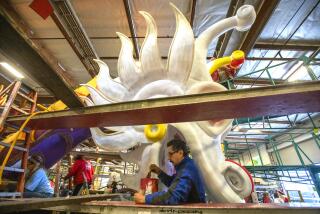Drawing On a Global Bouquet
The real business of the Rose Parade has always been Southern California’s business, and the essence of Pasadena’s annual floral festival has changed along with the region’s economy.
More than a century ago, a quintessentially California concept--manicuring nature into personal fantasies on wheels--was harnessed to promote the region’s most important growth industry, local land development. Today, from start to finish, the Tournament of Roses parade reflects Southern California’s crucial stake in the new, highly integrated global economy.
This year’s Rose Parade was the culmination of a carefully choreographed production that swung into action months ago in greenhouses and flower fields half a world away.
Magnificent roses from Ecuador and spectacular orchids from Asia, sky-blue iris from Israel and brilliant tulips from Holland all converge on Pasadena in the week between Christmas and New Year’s in a dramatic display of the region’s now-routine interconnection with every corner of the world.
In fact, most of the millions of flowers affixed to the five dozen floats that made their way down Colorado Boulevard on Thursday were grown outside the United States.
The parade’s reliance on imported flowers reflects a degree of international interdependence that could never have been foreseen by the real estate promoters who conceived the Rose Parade in 1889.
In Pasadena’s cavernous buildings and billowing tents, where barren floats come alive in a blaze of color, hundreds of floral shipments arrived this week still bearing the destination tags for Los Angeles International Airport and the names of the designers who now work their magic on behalf of American sponsors, Japanese corporations, Thailand’s national airline and a European tire maker.
Proudly displaying some of the most exotic and fragile orchids alongside 150 other flower varieties decorating the Unocal float, floral designer Kevin Claywell said the motorized multinational bouquet “represents a lot of different places in the world.”
The international character of the oil company’s float is readily apparent as Claywell points out the purple cattleyas and magenta phalaenopsis orchids from Hawaii and the Philippines, the yellow tulips from Holland, the soft peach roses from Ecuador and a rainbow of smaller rose varieties grown in Southern California.
Although floral designers are reluctant to discuss their budgets, it is clear that the flowers command a multimillion-dollar price tag even on the wholesale market.
For instance, Claywell estimated the flowers on the Unocal float cost between $60,000 and $70,000. Some of the orchids cost $2 to $3.50 a bloom, with the rarest commanding as much as $7 apiece.
During the last 10 days of December, the flowers must be cut, sorted, counted, packed, shipped, received, inspected, distributed, cleaned, conditioned and placed in their own plastic vials of water before taking their place on the float, Claywell said.
From the first arrivals the day before Christmas Eve to the last floral shipment received at midday on New Year’s Eve, the work of assembling all the flowers for Unocal’s float alone is an almost nonstop juggling act.
Multiply that by 24 floats and you have the job of Charlie Phillips, the flower coordinator for Phoenix Decorating Co.--the largest producer of Rose Parade floats.
“They call it hell week,” Phillips said between radio calls from increasingly desperate crew chiefs short on the perfect color flower needed to complete their float. “We scramble like mad.”
A landscape designer in the off-season, Phillips becomes the gatekeeper for 2 million flowers that were placed on the company’s two dozen floats in this year’s parade.
“You have to be really well-organized, really on top of it,” he said.
Take a peek at the floral boxes and you instantly see the global nature of this enterprise. There are boxes bearing shipping tags from international airlines. “This is the only parade of its kind in the whole world,” he said.
There are buckets of anthurium from Hawaii in purple, red and green, orange, white and pink. On plastic foam mats, waiting their turn, are 140,000 roses grown in California, or imported from Ecuador and sometimes Colombia, Guatemala or Honduras.
This is the end of the line for work that begins many months earlier when float designers and their floral decorators consult with flower brokers whose business is to buy around the globe.
Bette Lou Barker, floral production manager for Charisma Floats, which supplies Los Angeles’ signature events--the Rose Parade and the Academy Awards--relies heavily on a broker who knows growers around the world.
Barker, who has a degree in floral design, said she is “very much aware of the flower market, how flowers are processed and handled.”
She marvels at how advanced Holland’s flower market has become. Orders are processed by computer, funds are transferred electronically, flowers are cut, shipped and can arrive within a day.
Because of the long lead time in planting and securing the 30,000 roses she needs for four floats, Barker placed orders last summer.
The Ecuadorean roses have become her favorite for their high quality, large flowers, petal count and color.
At the Southern California Flower Market in downtown Los Angeles, Jaime Munoz, president of Golden Rose, a company that grows and imports Rosas del Ecuador, said Quito’s location on the equator ensures long days of sunlight and cool nights perfect for growing roses.
But globalization creates its own problems as well as opportunities.
Barker recalls the days when boxes of roses were left on the runway in Colombia because of heavy holiday passenger traffic. Or when flowers arrived at Los Angeles International Airport on the weekend before New Year’s and there was no one to inspect and release them.
Claywell remembers when agricultural inspectors found an unwanted insect in a shipment of flowers from Southeast Asia that was destined for Pasadena. “They are very, very strict in Los Angeles on what comes in here,” he said.
The flowers were quarantined, fumigated and arrived discolored, setting off a frantic search for replacements.
Then, even in a global enterprise, there are the purely local difficulties.
After thousands of miles of travel, there is one more hurdle the globe-trotting flowers must clear before starring in the New Year’s parade--cool December nights in Pasadena, where temperatures have been known to drop into the low 30s.
“It is a very, very challenging week,” Barker said.


